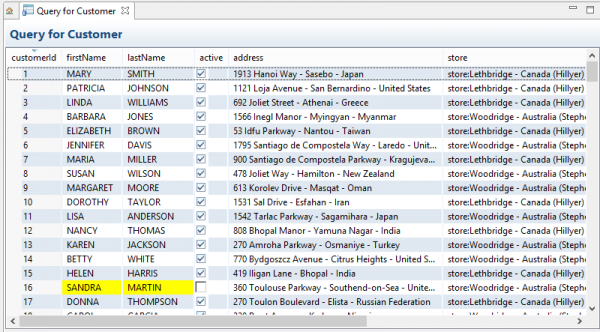Adichatz generates one XML file by entity to display query result in a table control.
For example, the generated file for a Customer class is described by an XML file called $projectDirectory/resources/xml/model/customer/CustomerTIGENERATED.axml:
<?xml version="1.0" encoding="UTF-8" standalone="yes"?>
<includeTree xmlns:xsi="http://www.w3.org/2001/XMLSchema-instance" xsi:noNamespaceSchemaLocation="http://www.adichatz.org/xsd/v0.9.1/generator/includeTree.xsd">
<table sortedColumn="customerIdTC" entityURI="adi://myproject/model.customer/CustomerMM" id="table">
<include adiResourceURI="#PARAM(CONTEXT_MENU)" id="tableContextMenu"/>
<crossReferences>
<crossReference entitySetId="rentals" description="#MSG(customer, rentals)" axmlDetailURI="adi://myproject/model.rental/RentalDI" axmlTableURI="adi://myproject/model.rental/RentalTI" axmlQueryURI="adi://myproject/model.rental/RentalQUERY"/>
<crossReference entitySetId="payments" description="#MSG(customer, payments)" axmlDetailURI="adi://myproject/model.payment/PaymentDI" axmlTableURI="adi://myproject/model.payment/PaymentTI" axmlQueryURI="adi://myproject/model.payment/PaymentQUERY"/>
</crossReferences>
<tableColumn property="customerId" pattern="######" sorted="true" id="customerIdTC"/>
<tableColumn property="address" sorted="true" id="addressTC">
<columnText>return null != #ROW().address ? #ROW().address.address : "";</columnText>
</tableColumn>
<tableColumn property="store" sorted="true" id="storeTC">
<columnText>return null != #ROW().store ? String.valueOf(#ROW().store.getStoreId()) : "";</columnText>
</tableColumn>
<tableColumn property="firstName" sorted="true" id="firstNameTC"/>
<tableColumn property="lastName" sorted="true" id="lastNameTC"/>
<tableColumn property="email" sorted="true" id="emailTC"/>
<tableColumn property="active" pattern="CHECK_ONLY" sorted="true" id="activeTC"/>
<tableColumn property="createDate" sorted="true" id="createDateTC"/>
<tableColumn property="lastUpdate" sorted="true" id="lastUpdateTC"/>
</table>
</includeTree>
Remarks:
- Line 3 - Controller wraps a table control and hosts rows of type Customer.
- Line 4 - Context menu is passed as a parameter.
- Lines 5-8 - Links give acces to Cross references (e.g all rentals of a customer).
- Lines 11 and 14 - Displayed values for this column are computed.
After having completed query for Customer by adding jointures, displayed data can be enriched as shown below.
For example, create file $projectDirectory/resources/xml/model/cutomer/CustomerTI.xml.
<?xml version="1.0" encoding="UTF-8" standalone="yes"?> <includeTree xmlns:xsi="http://www.w3.org/2001/XMLSchema-instance" xsi:noNamespaceSchemaLocation="http://www.adichatz.org/xsd/v0.9.1/generator/includeTree.xsd"> <table sortedColumn="customerIdTC" entityURI="adi://myproject/model.customer/CustomerMM" id="table"> <include adiResourceURI="#PARAM(CONTEXT_MENU)" id="tableContextMenu"/> <crossReferences> <crossReference entitySetId="rentals" description="#MSG(customer, rentals)" axmlDetailURI="adi://myproject/model.rental/RentalDI" axmlTableURI="adi://myproject/model.rental/RentalTI" axmlQueryURI="adi://myproject/model.rental/RentalQUERY"/> <crossReference entitySetId="payments" description="#MSG(customer, payments)" axmlDetailURI="adi://myproject/model.payment/PaymentDI" axmlTableURI="adi://myproject/model.payment/PaymentTI" axmlQueryURI="adi://myproject/model.payment/PaymentQUERY"/> </crossReferences> <tableColumn property="customerId" pattern="######" sorted="true" id="customerIdTC"/> <tableColumn property="firstName" sorted="true" id="firstNameTC"> <columnBackground>return !row.isActive() ? #COLOR(SWT.COLOR_YELLOW) : null;</columnBackground> </tableColumn> <tableColumn property="lastName" sorted="true" id="lastNameTC"> <columnBackground>return !row.isActive() ? #COLOR(SWT.COLOR_YELLOW) : null;</columnBackground> </tableColumn> <tableColumn property="active" pattern="CHECK_ONLY" sorted="true" id="activeTC"/> <tableColumn property="address" sorted="true" id="addressTC"> <columnText>return null != #ROW().address ? #ROW().address.address + " - " + #ROW().address.city.city
 + " - " + #ROW().address.city.country.country : "";</columnText> </tableColumn> <tableColumn property="store" sorted="true" id="storeTC"> <columnText>return null != #ROW().store ? #MSG(customer, store) + ":" + #ROW().store.address.city.city + " - " + #ROW().store.address.city.country.country + " (" + #ROW().store.staff.lastName + ")" : "";</columnText> </tableColumn> <tableColumn property="email" sorted="true" id="emailTC"/> <tableColumn property="createDate" sorted="true" id="createDateTC"/> <tableColumn property="lastUpdate" sorted="true" id="lastUpdateTC"/> </table> </includeTree>
renders the following layout:

Explanations:
File CustomerTIGENERATED.axml is copied as file CustomerTI.axml, so that, if a generation process occurs, changes will not be affected.
- Lines 11 and 14: Background is Yellow when customer is not valid.
- Lines 18 and 21: Return computed value for store and address.
<columnText>return null != #ROW().address ? #ROW().address.address
+ " - " + #ROW().address.city.city
+ " - " + #ROW().address.city.country.country : "";</columnText>
is equivalent to
<columnText>
if (null != customer.getAddress())
return customer.getAddress().getAddress() + " - "
+ customer.getAddress().getCity().getCity() + " - "
+ customer.getAddress().getCity().getCountry().getCountry();
else
return "";
</columnText>
So, this table controller works with query containing all needed jointures. E.g. use example query described in page complete query.